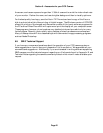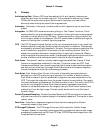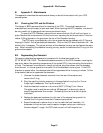Section 8 - Glossary
Page 45
8. Glossary
Antiblooming Gate - When a CCD pixel has reached its full well capacity, electrons can
effectively spill over into an adjoining pixel. This is referred to as blooming. Kodak
CCDs with the antiblooming option can be used to help stop or at least reduce
blooming when the brighter parts of the image saturate.
Astrometry - Astrometry is the study of stellar positions with respect to a given coordinate
system.
Autoguider - All SBIG CCD cameras have auto guiding or "Star Tracker" functions. This is
accomplished by using the telescope drive motors to force a guide star to stay precisely
centered on a single pixel of the CCD array. The camera has four relays to control the
drive corrector system of the telescope. The CCD camera head is installed at the guide
scope or off axis guider in place of a guiding eyepiece.
CCD - The CCD (Charged Coupled Device) is a flat, two dimensional array of very small light
detectors referred to as pixels. Each pixel acts like a bucket for electrons. The electrons
are created by photons (light) absorbed in the pixel. During an exposure, each pixel fills
up with electrons in proportion to the amount of light entering the pixel. After the
exposure is complete, the electron charge buildup in each pixel is measured. When a
pixel is displayed at the computer screen, its displayed brightness is proportional to the
number of electrons that had accumulated in the pixel during the exposure.
Dark Frame - The user will need to routinely create image files called Dark Frames. A Dark
Frame is an image taken completely in the dark. The shutter covers the CCD. Dark
Frames are subtracted from normal exposures (light frames) to eliminate fixed pattern
and dark current noise from the image. Dark Frames must be of the same integration
time and temperature as the light frame being processed.
Dark Noise - Dark Noise or Dark Current is the result of thermally generated electrons
building up in the CCD pixels during an exposure. The number of electrons due to
Dark Noise is related to just two parameters; integration time and temperature of the
CCD. The longer the integration time, the greater the dark current buildup. Conversely,
the lower the operating temperature, the lower the dark current. This is why the CCD is
cooled for long integration times. Dark noise is a mostly repeatable noise source,
therefore it can be subtracted from the image by taking a "Dark Frame" exposure and
subtracting it from the light image. This can usually be done with very little loss of
dynamic range.
Double Correlated Sampling - Double Correlated Sampling (DCS) is employed to lower the
digitization errors due to residual charge in the readout capacitors. This results in lower
readout noise.
False Color - False Color images are images that have had colors assigned to different
intensities instead of gray levels.
FITS Image File Format - The FITS image file format (which stands for Flexible Image
Transport System) is a common format supported by professional astronomical image
processing programs such as IRAF and PC Vista. CCDOPS can save image files in this
format but can not read them..


















